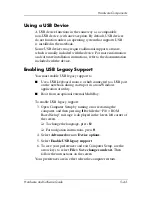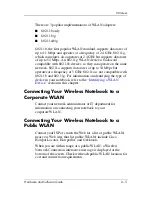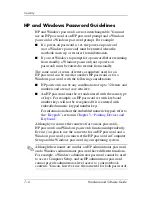
6–8
Hardware and Software Guide
Wireless
Using Wireless Security Features
When you set up your own WLAN or access an existing WLAN,
always ensure that security features are protecting the WLAN. If
you do not enable security on your WLAN, an unauthorized
wireless user can access your notebook data and use your Internet
connection without your knowledge.
The most common security levels are Wi-Fi Protected Access
(WPA)-Personal and Wired Equivalent Privacy (WEP). In
addition to enabling WPA-Personal or WEP security encryption
on the router, you may want to use one or more of the following
security measures:
■
Change the default network name (SSID) and password.
■
Use a firewall.
■
Set security on your Web browser.
■
Enable MAC address filtering on the router.
For more information about WLAN security, refer to the HP Web
site at
http://www.hp.com/go/wireless
for details.
Installing Wireless Software (Optional)
Microsoft Windows XP uses its Zero Client Configuration feature
to support WLAN configuration. HP provides a separate WLAN
configuration utility that must be installed if you plan to use
Cisco Compatible Extensions. Cisco Compatible Extensions
enable wireless devices to use Cicso-based WLANs.
















































